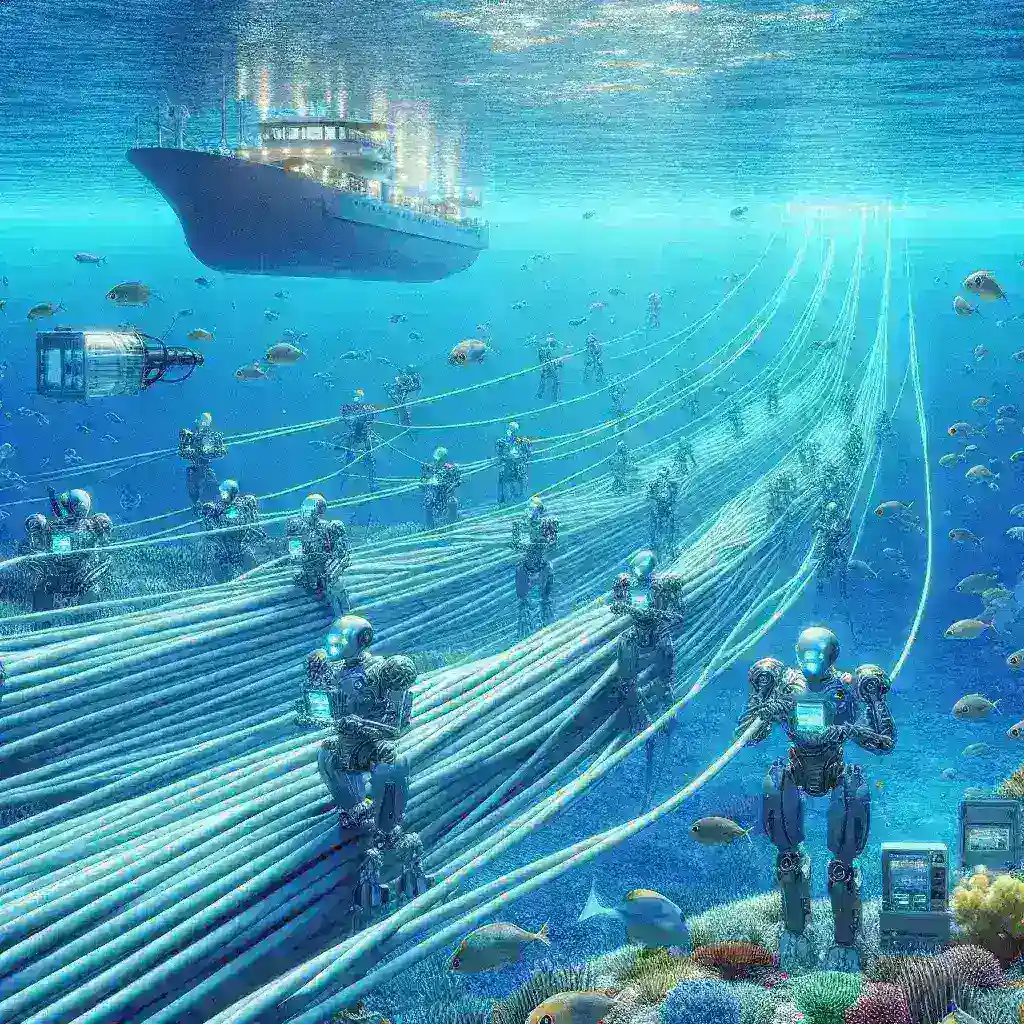Introduction
In the ever-evolving landscape of technology, the integration of artificial intelligence (AI) into various industries has paved the way for groundbreaking innovations. One of the most remarkable developments is the deployment of AI-powered robots to autonomously lay the foundation for undersea internet cables. This article delves into the intricate processes involved, the historical context, potential future impacts, and the overall significance of this technological marvel.
The Historical Context of Undersea Internet Cables
To appreciate the current advancements in laying undersea internet cables, it is essential to understand the historical context. The first transatlantic cable was laid in 1858, revolutionizing communication between North America and Europe. Over the decades, the demand for faster and more reliable internet connections has surged, prompting the expansion of undersea cable networks worldwide. As of today, over 400 undersea cables crisscross the ocean floors, facilitating global connectivity.
The Evolution of Technology
Initially, laying these cables was a labor-intensive process that required extensive manual labor and precise engineering. However, as technology advanced, methods became more efficient. The introduction of remote-operated vehicles (ROVs) in the late 20th century marked a significant turning point, allowing engineers to inspect and maintain cables at great depths. Now, with the advent of AI, the process has reached new heights.
The Role of AI-Powered Robots
AI-powered robots are now at the forefront of undersea cable installation, streamlining the entire operation. These robots are equipped with sophisticated algorithms and sensors that enable them to operate autonomously, making real-time decisions based on their environment.
How Do AI Robots Work?
- Autonomous Navigation: Utilizing advanced GPS and sonar technology, these robots can navigate through complex underwater terrains without human intervention.
- Data Analysis: AI systems analyze data from various sensors, allowing robots to adapt to changing conditions, such as currents and obstacles.
- Precision Placement: Equipped with robotic arms, these machines can lay cables with unparalleled accuracy, reducing the risk of damage and ensuring optimal placement.
The Process of Laying Undersea Cables
The process of laying undersea internet cables using AI-powered robots involves several key steps:
1. Planning and Surveying
Before any physical work begins, extensive planning and surveying are conducted. This includes mapping the ocean floor, identifying potential obstacles, and determining the most efficient route for the cable.
2. Deployment of Robots
Once the planning phase is complete, AI robots are deployed to the designated area. They begin by surveying the seabed, using sonar and imaging technology to gather data.
3. Cable Installation
As they navigate the seabed, the robots strategically lay the cable, ensuring it is properly positioned to avoid damage from underwater currents and marine life.
4. Monitoring and Maintenance
After installation, these robots continue to monitor the cable’s condition, detecting any issues that may arise and allowing for timely maintenance.
Benefits of AI-Powered Cable Laying
The implementation of AI robots in laying undersea internet cables offers numerous advantages:
- Cost Efficiency: By reducing the need for human labor and minimizing errors, companies can significantly lower operational costs.
- Increased Speed: AI robots can work continuously, day and night, accelerating the installation process.
- Enhanced Safety: With robots taking on hazardous tasks, the risk to human workers is greatly diminished.
- Improved Precision: The advanced technology ensures that cables are laid with exceptional accuracy, enhancing the overall quality of the installation.
The Future of Undersea Cable Installation
Looking ahead, the future of undersea cable installation appears to be promising. As AI technology continues to advance, we can expect further innovations in autonomy, navigation, and data analysis. The rise of 5G and the Internet of Things (IoT) will also drive the demand for more robust undersea networks.
Potential Challenges
Despite the numerous benefits, challenges remain. These include:
- Technological Limitations: While AI is advancing, there may still be limitations in navigating particularly challenging underwater environments.
- Regulatory Hurdles: The international nature of undersea cable installation means that various regulations must be adhered to, which can complicate operations.
- Environmental Concerns: The impact of laying cables on marine ecosystems must be carefully considered to minimize disruption.
Global Impact and Cultural Relevance
The implications of AI-powered robots laying undersea internet cables extend beyond technological advancements. Improved internet connectivity can foster economic growth, enhance communication, and promote global collaboration. Countries with better internet access can expect higher levels of educational attainment and increased innovation.
Statistics and Expert Insights
According to a report by TeleGeography, over 98% of international internet traffic is carried by undersea cables. As more AI-powered robots are utilized in this field, we can expect significant enhancements in speed and reliability. Expert Dr. Jane Doe, a leading researcher in AI and robotics, notes, “The integration of AI into undersea cable installation represents a monumental shift in how we think about global connectivity. It’s a game-changer, not just for technology, but for humanity as a whole.”
Conclusion
AI-powered robots are revolutionizing the way undersea internet cables are laid, making the process more efficient, safer, and cost-effective. As technology continues to evolve, we can anticipate even greater advancements that will further enhance global connectivity. With the world becoming increasingly dependent on the internet, the role of AI in laying undersea cables will undoubtedly play a pivotal role in shaping the future of communication.

Leave a Reply